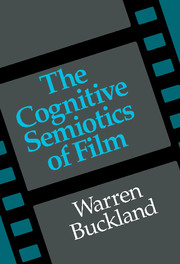Book contents
- Frontmatter
- Contents
- Preface and Acknowledgements
- 1 The Cognitive Turn in Film Theory
- 2 The Body on Screen and in Frame: Film and Cognitive Semantics
- 3 Not What Is Seen through the Window but the Window Itself: Reflexivity, Enunciation, and Film
- 4 The Institutional Context: A Semio-pragmatic Approach to Fiction and Documentary Film
- 5 All in the Mind? The Cognitive Status of Film Grammar
- Conclusion
- Notes
- Bibliography of Works Cited
- Index
3 - Not What Is Seen through the Window but the Window Itself: Reflexivity, Enunciation, and Film
Published online by Cambridge University Press: 02 December 2009
- Frontmatter
- Contents
- Preface and Acknowledgements
- 1 The Cognitive Turn in Film Theory
- 2 The Body on Screen and in Frame: Film and Cognitive Semantics
- 3 Not What Is Seen through the Window but the Window Itself: Reflexivity, Enunciation, and Film
- 4 The Institutional Context: A Semio-pragmatic Approach to Fiction and Documentary Film
- 5 All in the Mind? The Cognitive Status of Film Grammar
- Conclusion
- Notes
- Bibliography of Works Cited
- Index
Summary
In film, when enunciation is indicated in the utterance, it is not, or not essentially, by deictic imprints, but by reflexive constructions. … The film talks to us about itself, about cinema, or about the position of the spectator.
(Christian Metz)Throughout his career, Christian Metz was preoccupied – either directly or indirectly – with reflexivity in film. It is possible to identify three key moments: (1) his study of mirror constructions (construction en abîme) in Fellini's film 8½; (2) a theory of enunciation based on Emile Benveniste's distinction between histoire (hi/story) and discours (discourse); and (3) his seminars of the late eighties, culminating in his book L'Énonciation impersonnelle ou le site du film. In this chapter I will be investigating Metz's cognitive film semiotics (his theory of impersonal filmic enunciation), outlining the concepts it is based upon – particularly reflexivity, but also metalanguage and anaphora – and contrasting it with Francesco Casetti's cognitive film semiotics, a deictic theory of enunciation based on personal pronouns. I shall attempt to articulate what I see to be the main difference between Casetti and Metz: Whereas Casetti models his theory on speech (on face-to-face conversation), Metz implicitly models his theory on writing. Metz rejected a pronoun-based theory of enunciation because, he argues, pronouns are not appropriate to describing the ‘reality’ of film. But Metz also rejected all deictic concepts (concepts that designate how film is oriented to its contexts of production and reception).
- Type
- Chapter
- Information
- The Cognitive Semiotics of Film , pp. 52 - 76Publisher: Cambridge University PressPrint publication year: 2000



